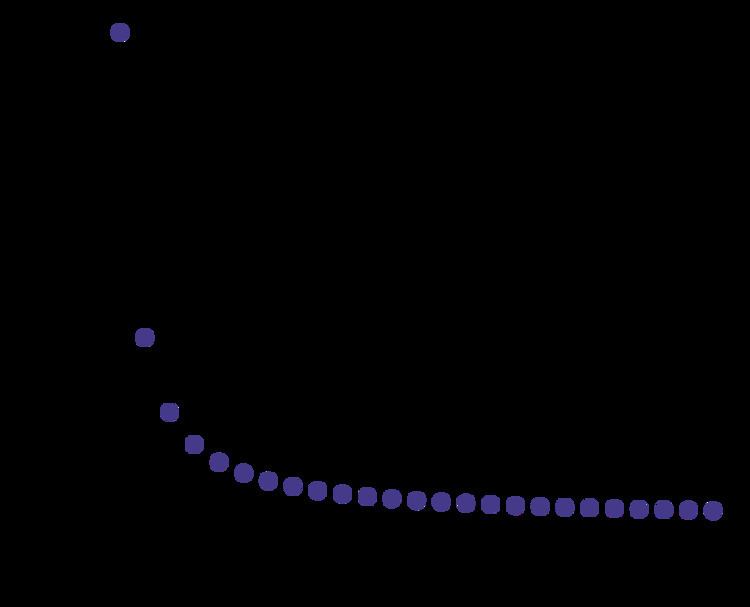 | ||
In mathematics, the limit of a sequence is the value that the terms of a sequence "tend to". If such a limit exists, the sequence is called convergent. A sequence which does not converge is said to be divergent. The limit of a sequence is said to be the fundamental notion on which the whole of analysis ultimately rests.
Contents
- History
- Real numbers
- Examples
- Formal definition
- Properties
- Infinite limits
- Definition
- Cauchy sequences
- Definition in hyperreal numbers
- References
Limits can be defined in any metric or topological space, but are usually first encountered in the real numbers.
History
The Greek philosopher Zeno of Elea is famous for formulating paradoxes that involve limiting processes.
Leucippus, Democritus, Antiphon, Eudoxus and Archimedes developed the method of exhaustion, which uses an infinite sequence of approximations to determine an area or a volume. Archimedes succeeded in summing what is now called a geometric series.
Newton dealt with series in his works on Analysis with infinite series (written in 1669, circulated in manuscript, published in 1711), Method of fluxions and infinite series (written in 1671, published in English translation in 1736, Latin original published much later) and Tractatus de Quadratura Curvarum (written in 1693, published in 1704 as an Appendix to his Optiks). In the latter work, Newton considers the binomial expansion of (x+o)n which he then linearizes by taking limits (letting o→0).
In the 18th century, mathematicians such as Euler succeeded in summing some divergent series by stopping at the right moment; they did not much care whether a limit existed, as long as it could be calculated. At the end of the century, Lagrange in his Théorie des fonctions analytiques (1797) opined that the lack of rigour precluded further development in calculus. Gauss in his etude of hypergeometric series (1813) for the first time rigorously investigated under which conditions a series converged to a limit.
The modern definition of a limit (for any ε there exists an index N so that ...) was given by Bernhard Bolzano (Der binomische Lehrsatz, Prague 1816, little noticed at the time) and by Karl Weierstrass in the 1870s.
Real numbers
In the real numbers, a number
Examples
Formal definition
We call
In other words, for every measure of closeness
Symbolically, this is:
If a sequence converges to some limit, then it is convergent; otherwise it is divergent.
Properties
Limits of sequences behave well with respect to the usual arithmetic operations. If
For any continuous function f, if
Some other important properties of limits of real sequences include the following (provided, in each equation below, that the limits on the right exist).
These properties are extensively used to prove limits without the need to directly use the cumbersome formal definition. Once proven that
Infinite limits
A sequence
Definition
A point x of the metric space (X, d) is the limit of the sequence (xn) if, for all ε > 0, there is an N such that, for every
Properties
For any continuous function f, if
Limits of sequences are unique when they exist, as distinct points are separated by some positive distance, so for
Definition
A point x of the topological space (X, τ) is the limit of the sequence (xn) if, for every neighbourhood U of x, there is an N such that, for every
The limit of a sequence of points
Properties
If X is a Hausdorff space then limits of sequences are unique where they exist. Note that this need not be the case in general; in particular, if two points x and y are topologically indistinguishable, any sequence that converges to x must converge to y and vice versa.
Cauchy sequences
A Cauchy sequence is a sequence whose terms ultimately become arbitrarily close together, after sufficiently many initial terms have been discarded. The notion of a Cauchy sequence is important in the study of sequences in metric spaces, and, in particular, in real analysis. One particularly important result in real analysis is the Cauchy criterion for convergence of sequences: A sequence of real numbers is convergent if and only if it is a Cauchy sequence. This remains true in other complete metric spaces.
Definition in hyperreal numbers
The definition of the limit using the hyperreal numbers formalizes the intuition that for a "very large" value of the index, the corresponding term is "very close" to the limit. More precisely, a real sequence
Thus, the limit can be defined by the formula
where the limit exists if and only if the righthand side is independent of the choice of an infinite H.
